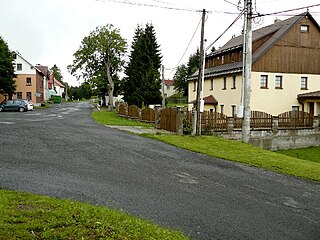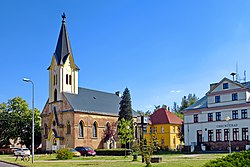
Sokolov District is a district in the Karlovy Vary Region of the Czech Republic. Its capital is the town of Sokolov.

Kraslice is a town in Sokolov District in the Karlovy Vary Region of the Czech Republic. It has about 6,600 inhabitants. It was a large and important town until World War II. It is known for the manufacture of musical instruments.

Sokolov is a town in the Karlovy Vary Region of the Czech Republic. It has about 22,000 inhabitants.

Ostrov is a town in Karlovy Vary District in the Karlovy Vary Region of the Czech Republic. It has about 16,000 inhabitants. The historic town centre is well preserved and is protected by law as an urban monument zone.

Holýšov is a town in Plzeň-South District in the Plzeň Region of the Czech Republic. It has about 5,700 inhabitants.

Kynšperk nad Ohří is a town in Sokolov District in the Karlovy Vary Region of the Czech Republic. It has about 4,500 inhabitants.

Vintířov is a municipality and village in Sokolov District in the Karlovy Vary Region of the Czech Republic. It has about 1,200 inhabitants.

Březová is a town in Sokolov District in the Karlovy Vary Region of the Czech Republic. It has about 2,600 inhabitants.

Habartov is a town in Sokolov District in the Karlovy Vary Region of the Czech Republic. It has about 4,700 inhabitants.

Krásno is a town in Sokolov District in the Karlovy Vary Region of the Czech Republic. It has about 700 inhabitants. It is historically associated with tin mining.

Nová Role is a town in Karlovy Vary District in the Karlovy Vary Region of the Czech Republic. It has about 4,200 inhabitants.

Nové Sedlo is a town in Sokolov District in the Karlovy Vary Region of the Czech Republic. It has about 2,600 inhabitants. It is known as an industrial town.

Oloví is a town in Sokolov District in the Karlovy Vary Region of the Czech Republic. It has about 1,600 inhabitants.

Přebuz is a town in Sokolov District in the Karlovy Vary Region of the Czech Republic. It is the smallest town in the Czech Republic by population, which was 76 inhabitants as of 2024.

Rotava is a town in Sokolov District in the Karlovy Vary Region of the Czech Republic. It has about 2,800 inhabitants.

Jindřichovice is a municipality and village in Sokolov District in the Karlovy Vary Region of the Czech Republic. It has about 500 inhabitants.

Krajková is a municipality and village in Sokolov District in the Karlovy Vary Region of the Czech Republic. It has about 900 inhabitants.

The Sokolov Basin or Falkenau Basin is a structural basin and geomorphological mesoregion of the Czech Republic. It is located in the central part of the Karlovy Vary Region. It is named after the town of Sokolov. It is known for its deposits of lignite, which has been extracted here to a greater extent since the second half of 19th century.

Neurohlau was a subcamp of Flossenbürg concentration camp, mainly for women prisoners of several European nationalities including Czech, Soviet, Yugoslavian, Belgian, Polish, and German. It was located on the edge of the municipality Neurohlau in the historical territory of Sudetenland. The Germans founded the camp in the autumn of 1942 and closed it in April 1945. Its main purpose was providing workers for the nearby Bohemia porcelain factory. At least 41 prisoners died in the camp ; about 500 died during the death march out in April 1945; an unknown number died after their deportation back to the mother camps ; and some others were burnt in the camp in Karlovy Vary. After World War II, the camp served as a collecting camp for prisoners of war before their removal to Germany.

Medard is an artificial lake in the Karlovy Vary Region of the Czech Republic, northwest of Sokolov, in the territories of Svatava and Habartov. The lake was created by flooding the former coal mine called Medard-Libík. The lake's surface area stretches 493 ha, its maximum depth is 50 m and the capacity is approximately 50 mil. m3. It is the largest lake in the Czech Republic.
























